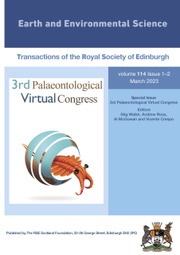Article contents
XXIV.—The Igneous Geology of the Burntisland District
Published online by Cambridge University Press: 06 July 2012
Extract
The district examined in the course of the research embodied in this paper is the south-eastern part of the county of Fife, lying between the coast-towns of Aberdour and Kirkcaldy, and stretching inland to a roughly semicircular boundary enclosing Auchtertool, Raith and Chapel. The area within these limits, amounting to approximately 30 square miles, was mapped on a scale of 6 inches to a mile, and the chief results of the field-work are shown in the map on Plate III.
- Type
- Research Article
- Information
- Earth and Environmental Science Transactions of The Royal Society of Edinburgh , Volume 53 , Issue 3 , 1925 , pp. 479 - 501
- Copyright
- Copyright © Royal Society of Edinburgh 1925
References
1860. Brown, Thomas, “Notes on the Mountain Limestone and Lower Carboniferous Rocks of the Fifeshire Coast from Burntisland to St Andrews,” Trans. Roy. Soc. Edin., vol. xxii, pp. 389–391.Google Scholar
1814. Daubuisson, , Basalts of Saxony, translation by Dr Neill, P., Edinburgh, note facing p. 215.Google Scholar
1897. Sir Geikie, A., The Ancient Volcanoes of Great Britain, London, chapters xxvi-xxviii.CrossRefGoogle Scholar
1839. Maclaren, Charles, The Geology of Fife and the Lothians, Edinburgh, pp. 82, 107.Google Scholar
1910. Dr Matley, C. A., “The Lower Carboniferous Rocks near Aberdour (Fife),” Trans. Geol. Soc. Edin., vol. ix, p. 364.CrossRefGoogle Scholar
1900. “The Geology of Central and Western Fife and Kinross,” Mem. Geol. Survey.Google Scholar
1902. “The Geology of Eastern Fife,” Mem. Geol. Survey.Google Scholar
1923. Dr Walker, F., “The Igneous Geology of the Dalmeny District,” Trans. Roy. Soc. Edin., vol. liii, p. 361.Google Scholar
- 12
- Cited by


